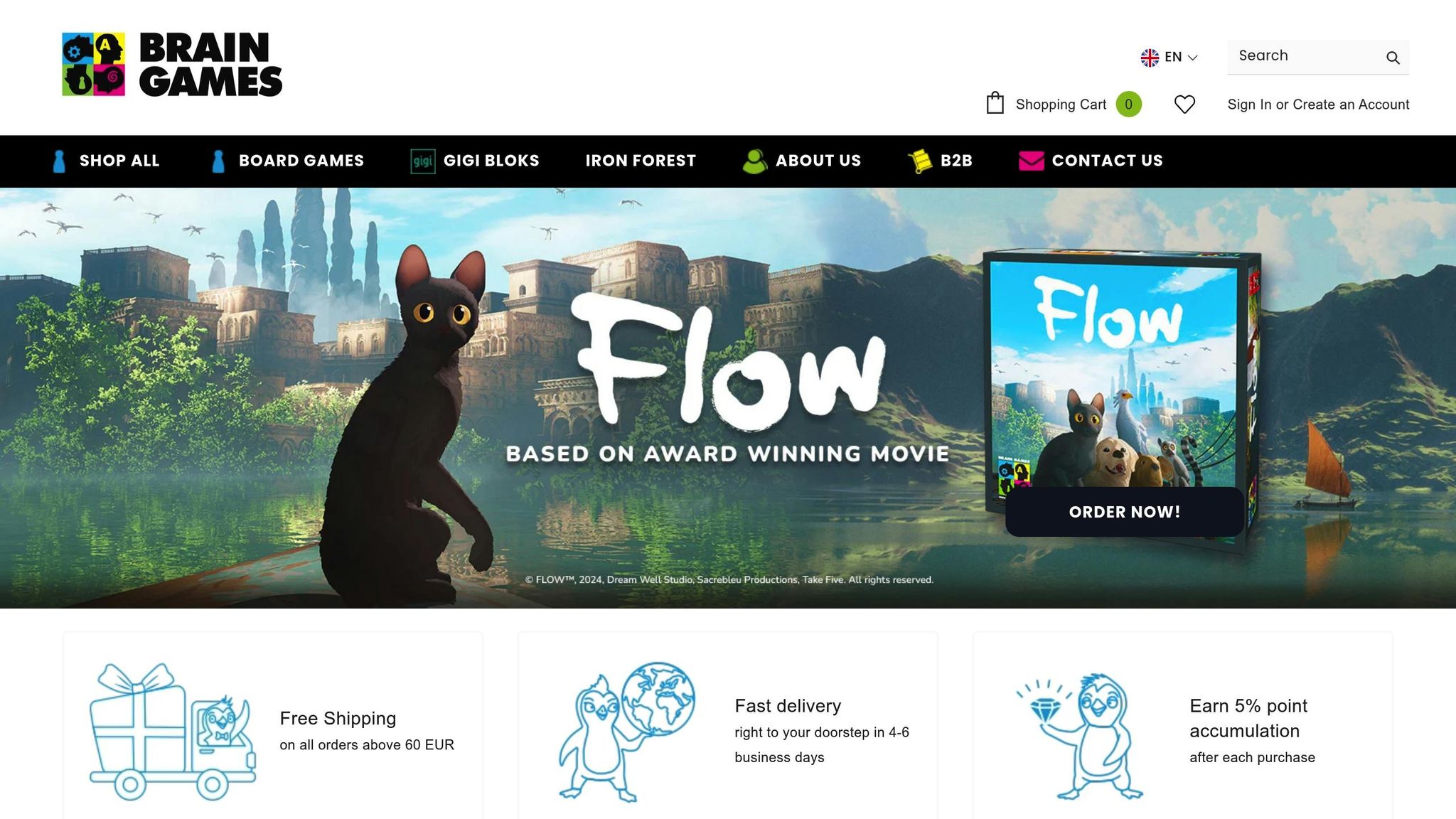Discover the Best Board Games for Every Player

Board Game Terms: Beginner Glossary
New to board games? Understanding common board game terms can make learning and playing much easier. Here's a quick guide to essential concepts:
- Action Points: Limit the number of moves you can make per turn.
- Area Control: Compete to dominate regions for points.
- Deck Building: Build and improve your card deck as you play.
- Worker Placement: Assign tokens (meeples) to actions, often blocking others.
- Drafting: Choose cards/resources from a shared pool strategically.
- Player Interaction: Games can be cooperative, competitive, or a mix.
- Game Components: Includes meeples, dice, cards, and boards.
Knowing these terms helps you grasp rules, plan strategies, and enjoy games more confidently. Ready to dive deeper? Let’s explore!
Board Game Terms Explained
Basic Game Mechanics
Board games rely on specific systems to create engaging and strategic experiences.
Action Points and Area Control
Action Points (AP) determine how many moves a player can make during their turn. For instance, in Pandemic, players have four actions per turn, which they can use to move, cure diseases, or build research stations. Similarly, Kemet gives players five action points to spend on tasks like buying power tiles, upgrading pyramids, or recruiting troops.
Area Control focuses on dominating specific regions on the board. Players compete to influence or control these areas, often earning points based on their presence. This mechanic forces players to make tough decisions about where to focus their efforts, balancing offense and defense.
Deck Building and Worker Placement
Deck building is all about starting with a basic set of cards and gradually improving it as the game progresses. As BoardGameGeek explains:
"A deck-building game is a card game or board game where construction of a deck of cards is a main element of gameplay."
Games like Dune: Imperium and Lost Ruins of Arnak combine deck building with worker placement for deeper strategy. In these games, the deck represents your resources, while worker placement determines how you use them.
In worker placement, players assign their limited tokens (commonly called "meeples") to specific action spaces. Once a space is occupied, it’s usually blocked or becomes more costly for others, which adds urgency and forces players to plan wisely.
Drafting and Core Rules
Drafting introduces strategy by allowing players to pick cards or resources from a shared pool. This mechanic often works alongside others to add depth.
For example, in Clank!, deck building drives exploration as players delve deeper into a dragon’s lair. The game adds tension by blending resource management with risk-taking, challenging players to weigh their ambitions against the danger of awakening the dragon.
These mechanics are the foundation of many modern board games. In fact, BoardGameGeek lists 6,759 games that incorporate action point systems.
Player Interaction Types
Understanding how players interact - whether through teamwork or rivalry - can shape strategic decisions and make games more enjoyable. These interaction patterns also help players find games that suit their playing style.
Team Play vs. Competition
Team-based games introduce a dynamic where players must cooperate with teammates while competing against opponents. As Dave Eng explains:
"Interaction is an incredibly critical element of game play in team games. As in these cases, players need to be able to coordinate and cooperate in order to position their team to win."
Some games are entirely cooperative, where players join forces to overcome the game itself. Others are competitive, focusing on direct player-versus-player action. A newer category, semi-cooperative (or co-petitive) games, blends the two, requiring players to collaborate at times but also compete when necessary. For those who prefer less direct interaction, games with minimal player engagement are a great option.
This balance of cooperation and competition often leads to varying levels of conflict and negotiation between players.
Player Conflict and Deals
Conflict in games can range from subtle interference to outright confrontation. Some mechanics allow players to directly impact their opponents, while others involve more indirect strategies, like blocking access to resources.
Negotiation is another layer that adds complexity to gameplay, emphasizing communication and deal-making. Nick Murray highlights its appeal:
"Negotiation is one of my all-time favorite ingredients in tabletop games. It's a mechanism that steps out of the way and lets the players do the talking, literally."
Building trust is key to successful negotiation, as experienced players know that deception can damage future alliances. The game Inis illustrates this well with its conflict resolution system, which simplifies combat by asking: "Would you like to stop fighting?" If both players agree, the conflict ends.
Getting Knocked Out
In some games, escalating conflicts can lead to a player being completely removed from play. This mechanic, known as player elimination, leaves participants watching from the sidelines before the game concludes. To address this, many modern games have shifted away from elimination, offering alternatives to keep everyone involved. These include:
- Temporary setbacks: Players lose turns or resources but remain in the game.
- Comeback mechanics: Struggling players gain special abilities or bonuses to stay in the competition.
- Ghost players: Eliminated participants can still influence the game in limited ways.
The focus on keeping all players engaged until the end ensures a more inclusive and enjoyable experience for everyone.
sbb-itb-1ed942f
Game Pieces and Parts
Board games rely on physical components to shape the gameplay. Understanding these elements helps players grasp the rules more quickly.
Playing Pieces and Dice
Player markers, such as meeples, are a hallmark of German-style board games. These markers come in various forms, each serving a distinct purpose:
- Miniatures: Detailed figures often used in adventure or role-playing games.
- Pawns: Basic pieces designed for straightforward movement.
- Tokens: Used to track resources, points, or player status.
- Coins: Represent in-game currency (e.g., doubloons in pirate-themed games).
These pieces are crafted from different materials, each with unique qualities:
| Material Type | Features | Common Uses |
|---|---|---|
| ABS Plastic | Durable and pricier | Miniatures, dice |
| Wood | Sturdy with a classic feel | Meeples, pawns, cubes |
| Glass | Sleek and decorative | Gems, marbles |
| Metal | Heavy and long-lasting | Coins, special editions |
While player markers represent a player's presence on the board, other components like cards and boards lay the foundation for the game’s structure.
Cards and Boards
Cards and boards work alongside player markers to organize gameplay. In deck-building games like Dominion, cards play dual roles as both actions and resources. Players start with a set of 10 cards and expand their deck by purchasing new ones from a central supply.
Game boards, typically made from durable cardboard, are key to a game's longevity. For instance:
- Durability: High-quality boards can handle compression strengths of up to 200 pounds.
- Materials: Often made from grayboard covered with printed paper.
- Flexibility: German black core paper can bend up to 20 times without showing wear.
Cards often serve multiple purposes. In 7 Wonders, for example, cards are used to construct city buildings, trade for resources, or help build wonders. Premium cards are designed to last, featuring high opacity, vibrant colors, and durable materials.
Modern board games frequently combine these elements - wooden tokens for resources, specialized dice for outcomes, and more - to deliver immersive and interactive experiences.
Higher-Level Gaming Terms
Advanced board games introduce strategies that go beyond basic mechanics, helping players refine their gameplay and interactions. These terms and concepts can deepen your understanding and improve your strategic approach.
Decision Paralysis
Sometimes, players face so many choices that they struggle to make a decision, slowing the game down. This is often called analysis paralysis and can happen for several reasons, including too much information, fear of making the wrong move, or overthinking. Here's a quick breakdown:
| Cause | Effect | How to Address It |
|---|---|---|
| Too much information | Slows decisions | Break choices into smaller, manageable steps |
| Perfectionism | Creates stress | Use time limits to stay focused |
| Fear of upsetting others | Hesitant moves | Prioritize fun over perfect decisions |
| Lack of confidence | Prolonged turns | Seek advice from others to build clarity |
"Analysis paralysis is the act of over-analyzing or overthinking a situation to the point where a decision or action is never taken", explains Misel Brkic.
To keep the game flowing, players can set personal time limits or simplify their choices. If a fellow player seems stuck, offering friendly advice or helping them narrow down options can encourage quicker decisions.
Once you’ve tackled decision-making challenges, understanding game engines can take your strategy to the next level.
Game Engines and Campaign Games
Game engines are the mechanics that power a game's strategy. They determine how players make decisions and interact with the game. In deck-building games, for example, the engine often revolves around combining cards to produce resources or trigger actions.
"For every distribution of resources between the three boxes, there is a distribution that beats it in two out of three",.
This highlights how game engines create layers of strategy by linking different mechanics together.
Campaign games, on the other hand, bring a long-term element to gameplay. These games often include:
- Evolving Rules: Rules that change and grow over multiple sessions.
- Story Integration: A narrative that unfolds as the game progresses.
- Permanent Choices: Decisions that carry over and shape future sessions.
- Cooperative Play: A focus on teamwork and shared goals.
Where to Buy Games
Finding reliable places to buy board games is essential for growing your collection. You’ve got plenty of options, including specialty retailers, community-driven marketplaces, and local shops.
| Store Type | Best For | Features |
|---|---|---|
| Specialized Retailers | New releases, big variety | Loyalty programs, regular sales |
| Community Marketplaces | Rare finds, secondhand games | Peer-to-peer transactions |
| Local Game Stores | Immediate access | Community events, expert advice |
Each option offers something different. Online retailers, like Brain Games, are particularly convenient and worth checking out.
Brain Games

Brain Games is a top online store with a massive selection of board games, including exclusive titles like ICECOOL and TEAM3.
If you’re shopping online, here are a few other great options to consider:
- Miniature Market – Known for big clearance discounts.
- BoardGameGeek Marketplace – Connects buyers and sellers worldwide.
- CoolStuffInc – Offers a rewards program for frequent shoppers.
For the best deals, try price comparison tools like BoardGameOracle.com. It scans discounts from multiple U.S. stores and highlights bargains, such as Carpe Diem at 65% off on Amazon. Many retailers also have newsletters that give you early access to sales and exclusive offers.
Brain Games stands out with perks like their Game Exchange Guarantee, a lifetime warranty on select games, and a curated selection designed for families and beginners.
Now that you know where to shop, you’re one step closer to leveling up your board game collection!
Next Steps
Now that you know the basics of board game terminology, it’s time to dive in and apply what you’ve learned. BoardGameGeek (BGG), a platform with a community of over two million users, is a fantastic resource to expand your knowledge. Their detailed game descriptions and mechanics tags make it easy to find games that align with your interests.
A great way to start is by trying out gateway games that highlight some of the mechanics you’ve explored. For instance, if you’re curious about deck-building, check out Dominion. If worker placement caught your attention, Lords of Waterdeep is a solid choice to get started.
| Mechanic Type | Recommended Gateway Game | What You’ll Learn |
|---|---|---|
| Deck Building | Dominion | Managing cards effectively |
| Worker Placement | Lords of Waterdeep | Allocating resources |
| Area Control | Ticket to Ride | Managing territories |
When you read reviews or game descriptions, try to spot the mechanics and terms you’ve just learned. This will help reinforce your understanding and make it easier to pick games you’ll enjoy. You can also browse Brain Games’ online catalog, which organizes games by mechanics, making it simple to discover titles that match your play style.
"BoardGameGeek is an online resource and community that aims to be the definitive source for board game and card game content." - BoardGameGeek
Joining online communities is another great way to connect with other players and deepen your understanding. The r/boardgames subreddit, with its 4.0 million members, is a friendly place for beginners to ask questions and share experiences. For hands-on practice, check out Board Game Arena, where you can play popular titles like Wingspan and Azul with millions of players worldwide.






